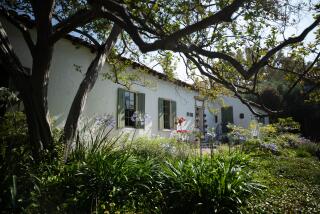Texas Archeologists Get a Final Crack at Excavating Lost French Fort
- Share via
VICTORIA, Texas — A bad map and good navigation made Ft. St. Louis the hottest piece of real estate for French and Spanish explorers racing for a foothold on the western Gulf Coast of North America.
French explorer Rene Robert Cavelier, Sieur de la Salle, landed in Lavaca Bay in 1685, intending to build a colony at the mouth of the Mississippi River.
But guided by poor cartography, he was 500 miles off target.
Undeterred, La Salle declared the land part of New France and founded Ft. St. Louis. Before he set out with 87 men to find his true goal, 180 settlers considered this home, albeit a temporary and inhospitable one.
La Salle’s accidental success was monumental, but not for the French and the future of France’s influence on Texas.
“The Spanish settlement of Texas is directly the result of France’s efforts to settle here,” says Jim Bruseth, the director of the Texas Historical Commission’s archeology division. “The presence of the French here absolutely drove the Spanish to distraction.”
Since October, the commission’s team of 16 archeologists has chipped through hard-packed clay soil, searching for secrets of the lost French and Spanish settlements and the birth of colonial Texas.
It is a rare opportunity to search the soil for Spain’s profound influence on Texas, and archeologists have only a short time to sift through the remains of the first European settlement.
The private Keeran Ranch Trust, which owns the secluded site, has allowed the historical commission two years of access. The legislature granted $250,000, and private donors added $750,000-- enough money to last through this October.
It is the third archeology dig. But the current excavation is the first since the site was definitively identified as Ft. St. Louis in 1996. Earlier ones were inconclusive.
The researchers call evidence of adobe and plaster structures found 8 inches underground convincing: This could be what’s left of Presidio La Bahia, the first Spanish fort in Texas, built in 1719 over the remains of the French outpost.
Ft. St. Louis was the farthest southern reach of New France, an area stretching from Canada across the middle third of what became the United States. At the same time La Salle landed, a four-year-old colony known as Pennsylvania was weathering an influx of immigrants from Germany and the British Isles.
The Spanish first got wind of La Salle’s mission to establish a foothold on the Gulf Coast after interrogating defectors from La Salle’s crew. During a 1684 stopover on what is now Haiti, they became pirates.
“The Spaniards sent out 11 missions by land and sea to find the site,” Bruseth says, “and the nice thing for us is that the Spanish were successful.”
Their success came four years after La Salle landed. But by then the settlement was empty, its occupants the victims of disease or marauding Karankawa Indians.
“This was the first high ground that La Salle came to on his way out of Lavaca Bay,” says Mike Davis, director of the commission’s dig at Ft. St. Louis. “He wanted something far enough away so he could hide from the Spaniards. And it’s a very strategic, defensible landform.”
The site is on a low bluff with a clear view of surrounding plains, about 30 feet above Garcitas Creek and four miles upstream from Lavaca Bay.
From the creek there’s no hint of the French colony, nor a trace of the stout Presidio La Bahia. But atop the barren slab of coastal prairie, in fresh-cut ditches, is evidence of three groups that called Ft. St. Louis home.
Tedious excavation has already yielded thousands of artifacts-- French and Spanish pottery shards, gun flints, 3,500-year-old Karankawa dart points, beads, rings, religious medallions, even Chinese porcelain brought by the Spanish. Diggers also uncovered several Spanish ficas, or small brass good-luck charms meant to ward off the evil eye.
Since the public is not allowed on the site--even the archeologists have to ride a boat to Ft. St. Louis under the terms of the agreement with the landowner--the historical commission set up a public archeology laboratory in a downtown Victoria storefront.
There volunteers and paid workers clean, restore and catalog the thousands of artifacts, and visitors can look at the restored items, read the history and ask questions.
Much of the information locating Ft. St. Louis comes from the diary of Henri Joutel, a La Salle lieutenant and one of only five people to return to France after the ill-fated voyage. La Salle was murdered by his own men near Navasota, some 150 miles to the north, after they set out for Illinois to get help for the struggling fort.
Archeologist Herbert Bolton found the site in 1914 while looking for Presidio La Bahia with a new map of the fortress he had retrieved from Spain. An excavation in 1950 unearthed several artifacts, but researchers weren’t able to discern Spanish pottery from French until 1973.
Definitive proof of Bolton’s theory did not come until 1996.
Commission archeologists unearthed eight iron cannons that La Salle took from the supply ship L’Aimable before it was wrecked. After discovering the remnants of Ft. St. Louis in 1689, Spanish explorer Don Alonso de Leon buried the cannons for later use--a later use that never came.
The Spanish did not return to found Presidio La Bahia for 30 years. From there, they moved into a new fort at Goliad and began colonizing Texas.
*
On the Net:
https://www.thc.state.tx.us
More to Read
Sign up for Essential California
The most important California stories and recommendations in your inbox every morning.
You may occasionally receive promotional content from the Los Angeles Times.













